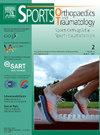Checkliste: Epiphysenfugenverletzungen im Sportklettern
Q4 Health Professions
引用次数: 0
Abstract
Im Sportklettern ist die Verletzung der dorsalen Epiphysenfuge der proximalen Mittelphalanx die häufigste Verletzung im Jugendbereich. Zumeist handelt es sich hierbei um Salter Harris III Frakturen, die durch repetitive Mikrotraumata entstehen. Es kommt zur Überlastung der dorsalen Epiphysenfuge durch intensives Training. Als Risikofaktoren gelten Grifftechniken mit aufgestellter Fingerposition (sog. Crimp) und das Trainingsgerät Campus board.
Das rechtzeitige Erkennen sowie die konsequente Therapie einer Epiphysenfugenverletzung sind entscheidend um Folgeschäden wie asymmetrisches Wachstum oder einen Wachstumstop zu verhindern. Die konservative Therapie mittels sofortiger Kletterpause und frühfunktioneller Behandlung führt im Regelfall zu sehr guten Ergebnissen.
In sport climbing, injuries to the dorsal epiphysial growth plate of the proximal middle phalanx are the most common injuries in adolescents. In most cases, these are Salter Harris III fractures caused by repetitive microtrauma. The dorsal part of the growth plate is affected by those overuse injuries as a result of intensive training. The crimp grip technique and the campus board training device are considered high-risk.
Timely recognition and consistent treatment of an epiphyseal growth plate injury are crucial to prevent asymmetrical growth or growth arrest. Conservative treatment by means of an immediate break from climbing and early functional treatment generally leads to very good results.
运动损伤清单
在运动攀岩中,近端中突背突损伤是青少年最常见的损伤。最常见的是由重复性微创伤引起的索尔特哈里斯III型骨折。这是通过高强度训练来实现的。手指直立的握法被认为是危险因素。“校园板”。及时发现和持续治疗附睾损伤对于防止不对称生长或生长停止等后续损害至关重要。早期治疗和早期功能治疗的保守治疗通常效果很好。在运动攀岩中,近端中指骨背外侧生长板的损伤是青少年最常见的损伤。在大多数情况下,这些骨折是由重复性微创伤引起的。由于高强度训练的结果,生长板的背部受到过度损伤的影响。你可以在这里找到所有你需要的信息。早期识别和持续治疗附生生长板损伤对预防不对称生长或生长停止至关重要。保守治疗是指立即停止攀登和早期功能治疗,通常会有很好的结果。
本文章由计算机程序翻译,如有差异,请以英文原文为准。
求助全文
约1分钟内获得全文
求助全文
来源期刊

Sports Orthopaedics and Traumatology
Health Professions-Physical Therapy, Sports Therapy and Rehabilitation
CiteScore
0.70
自引率
0.00%
发文量
145
审稿时长
43 days
 求助内容:
求助内容: 应助结果提醒方式:
应助结果提醒方式:


